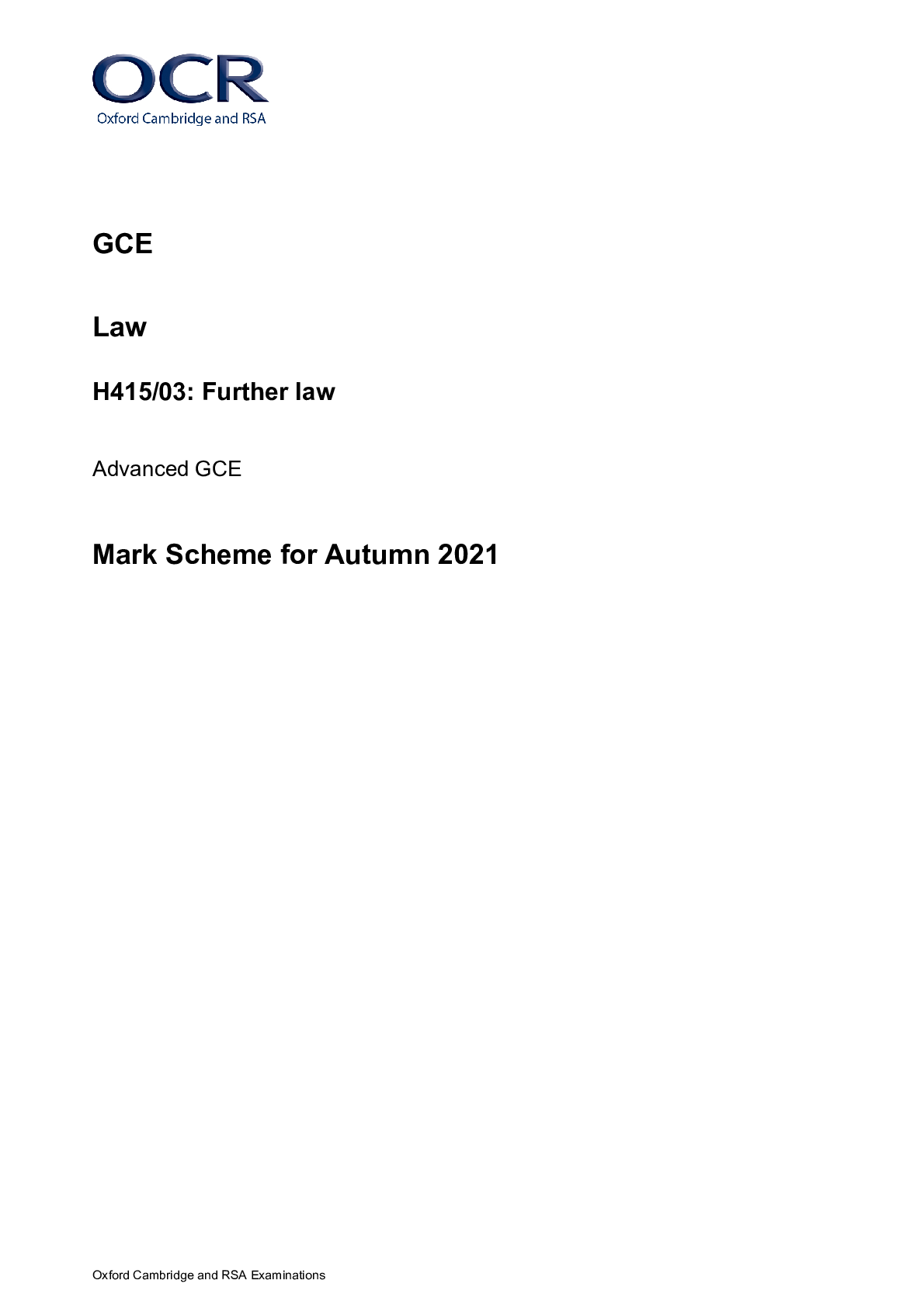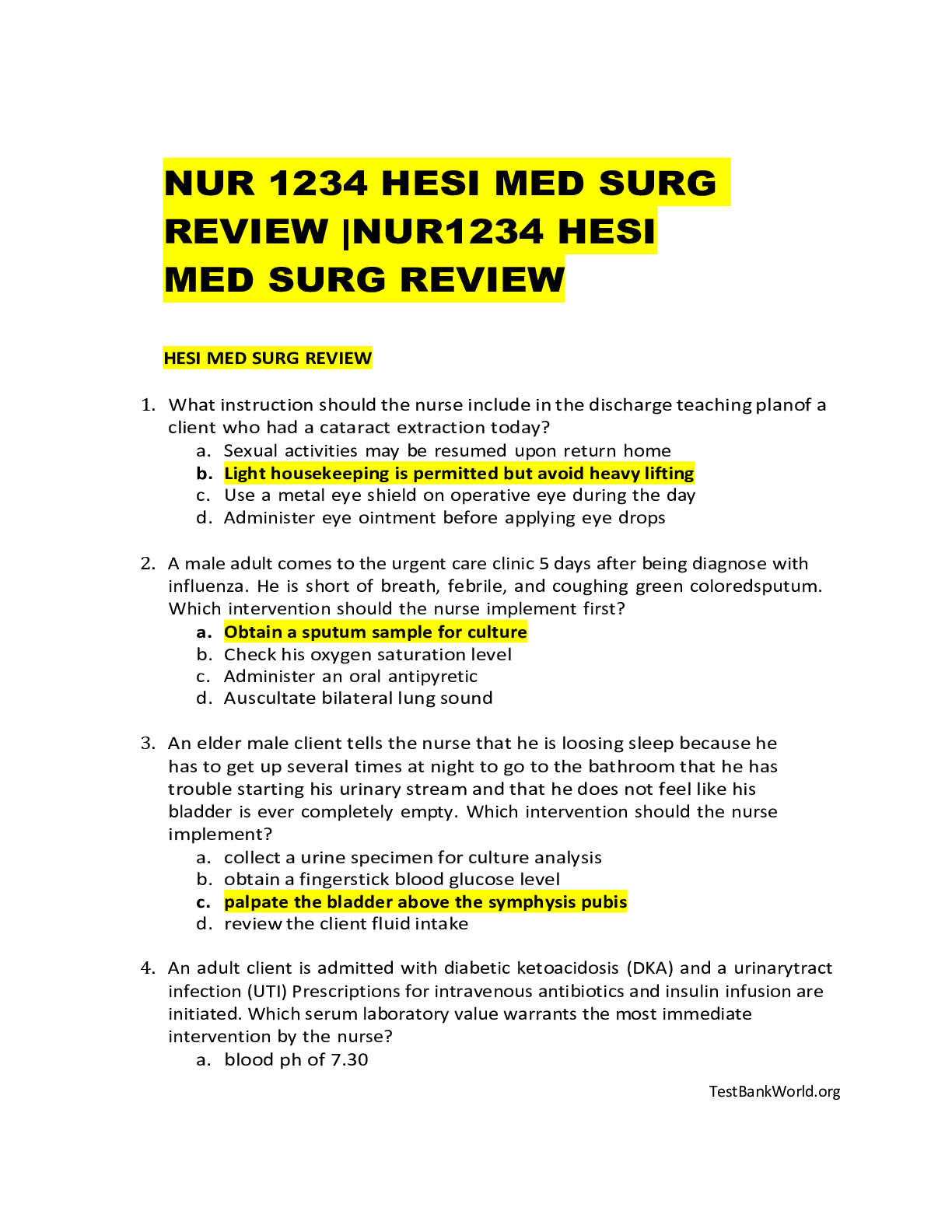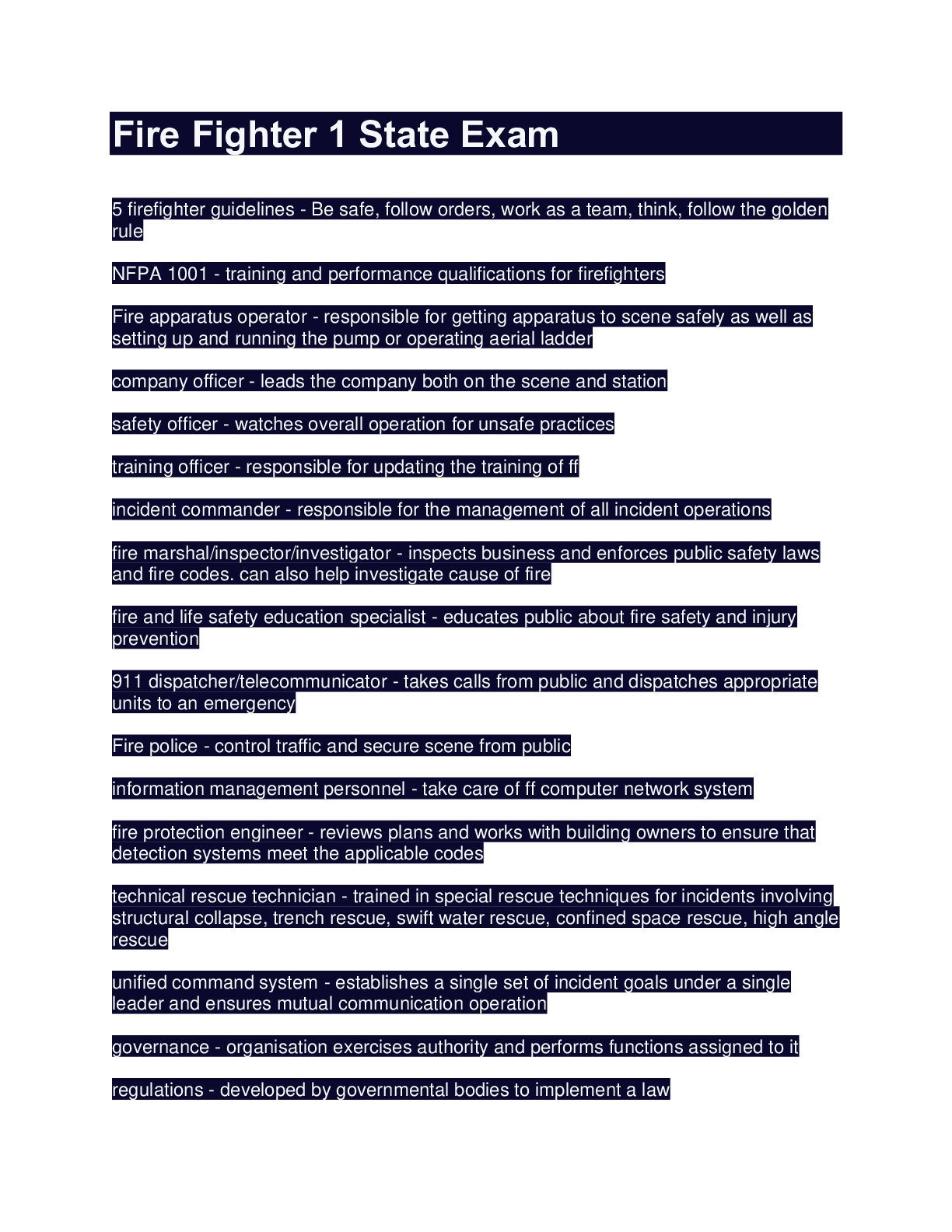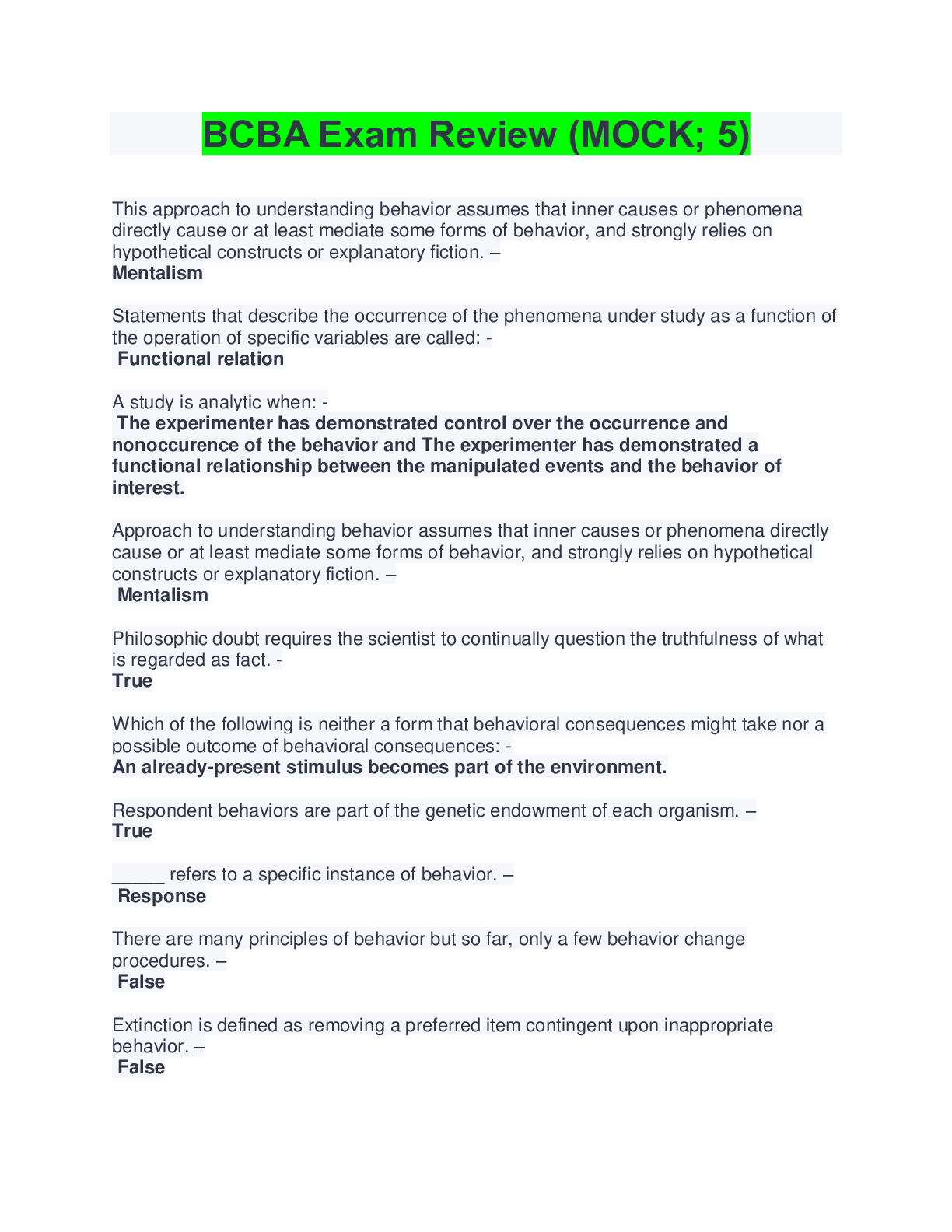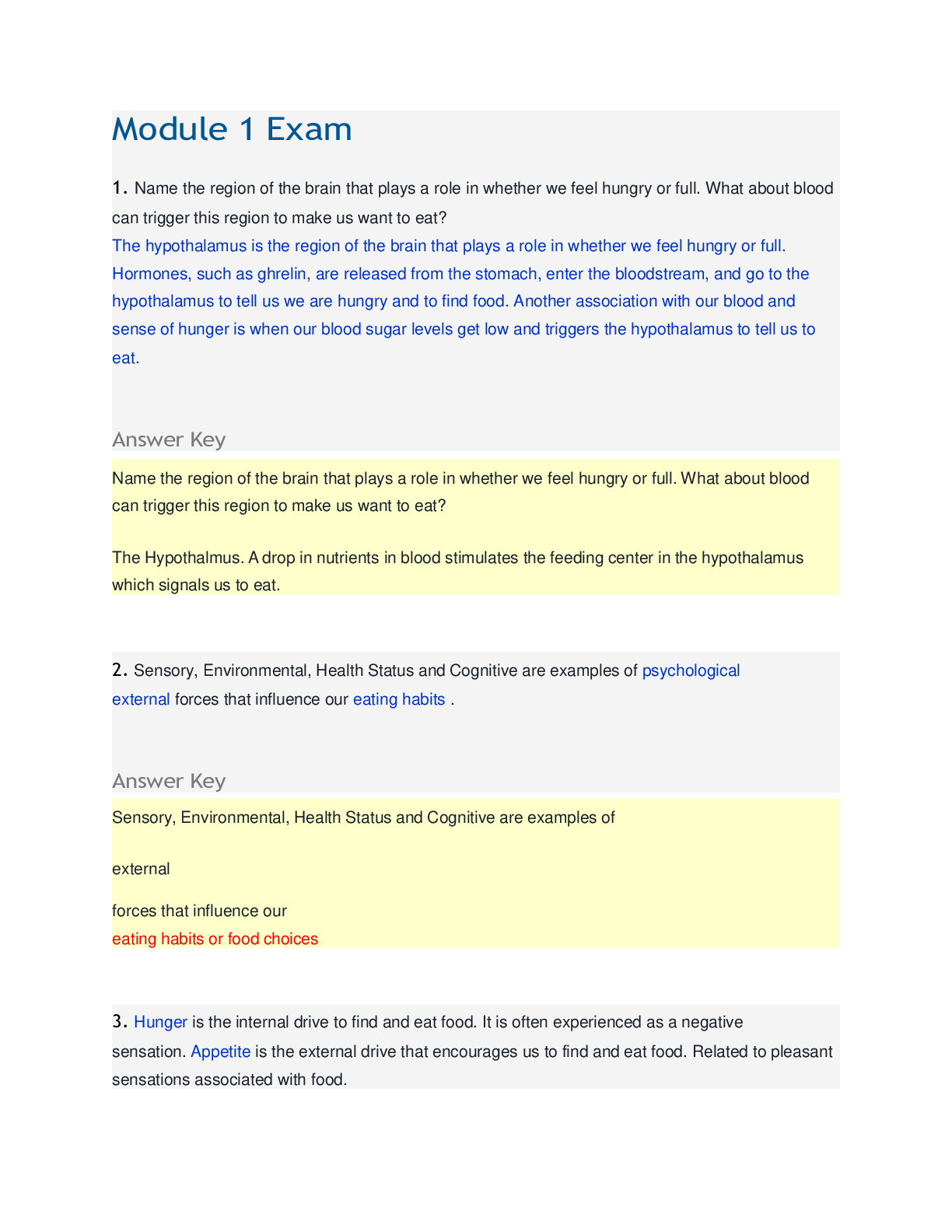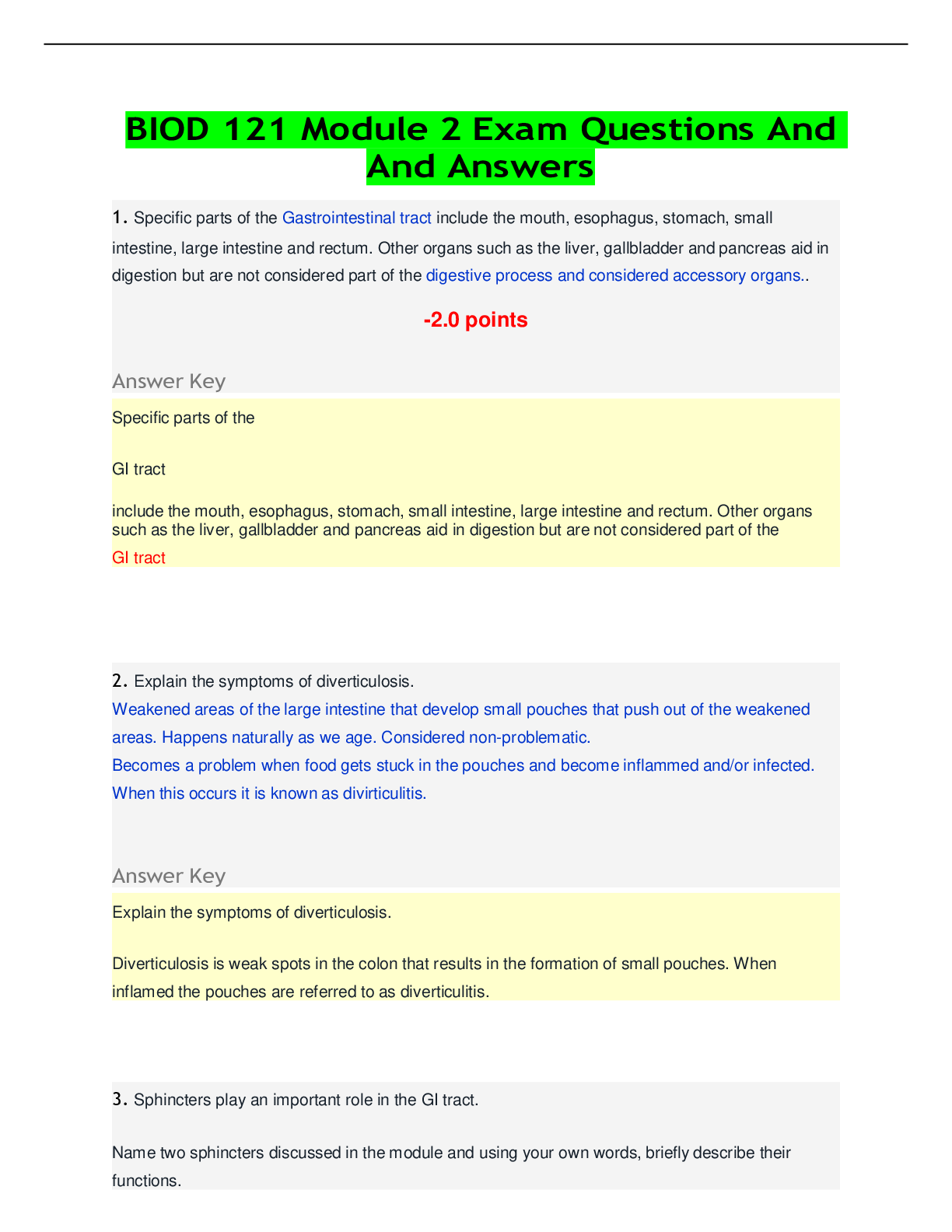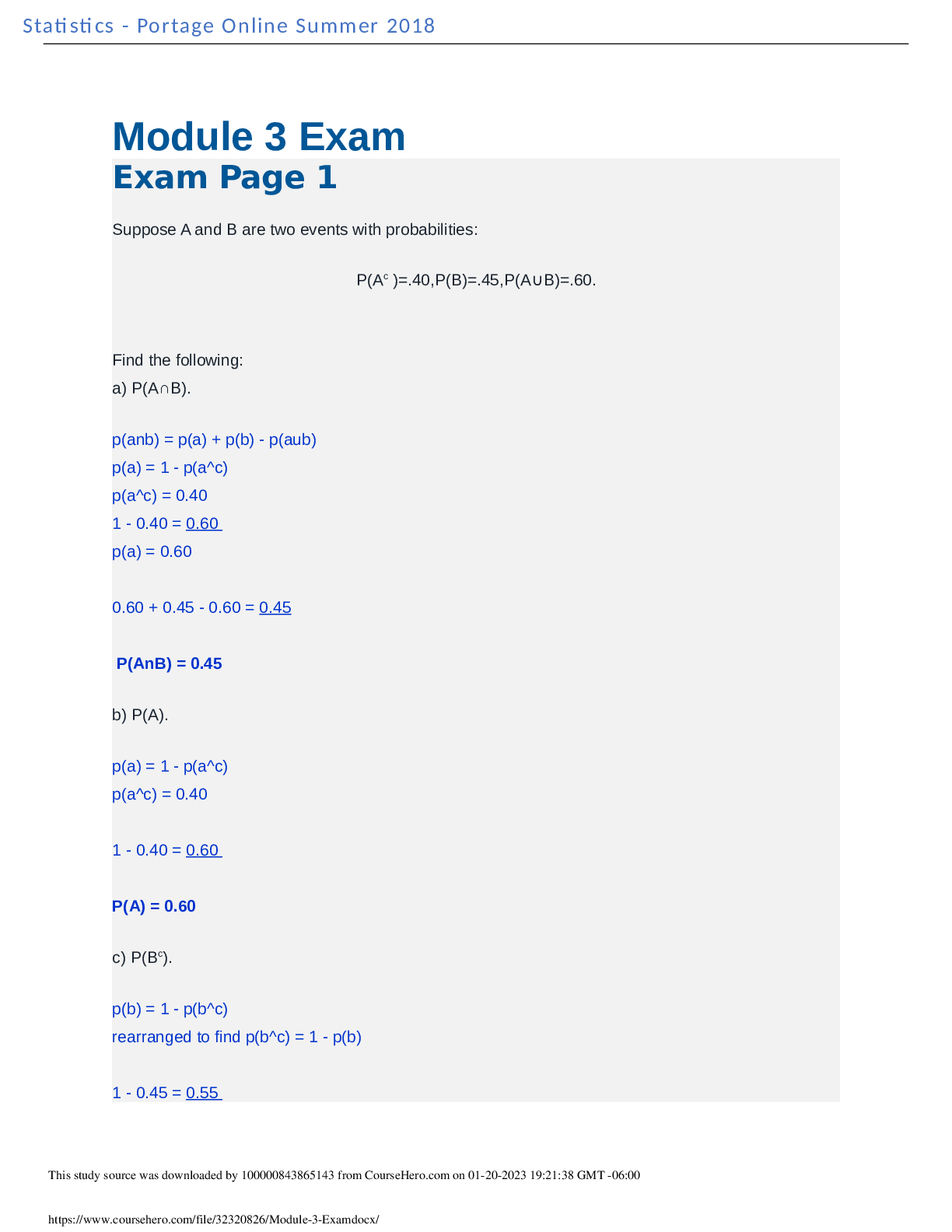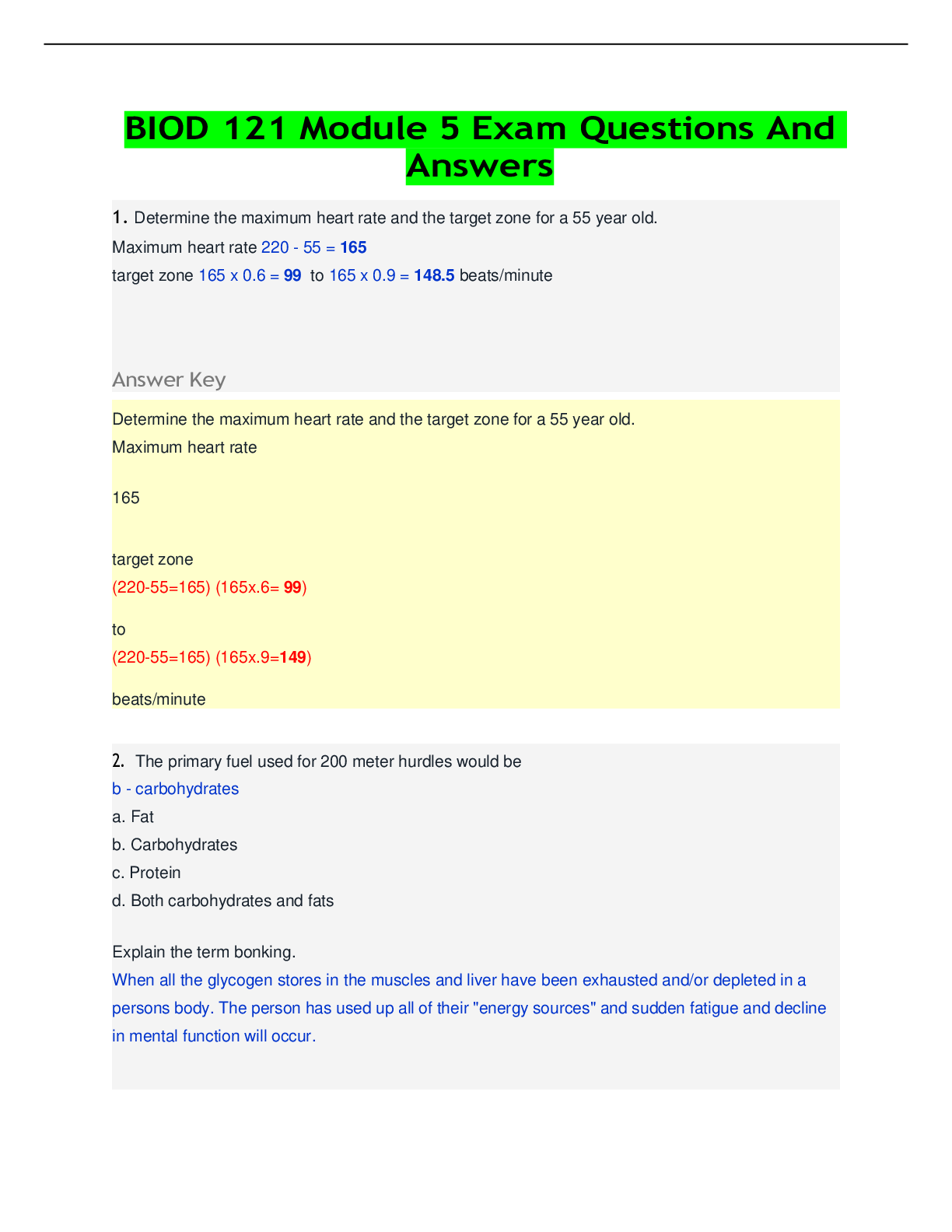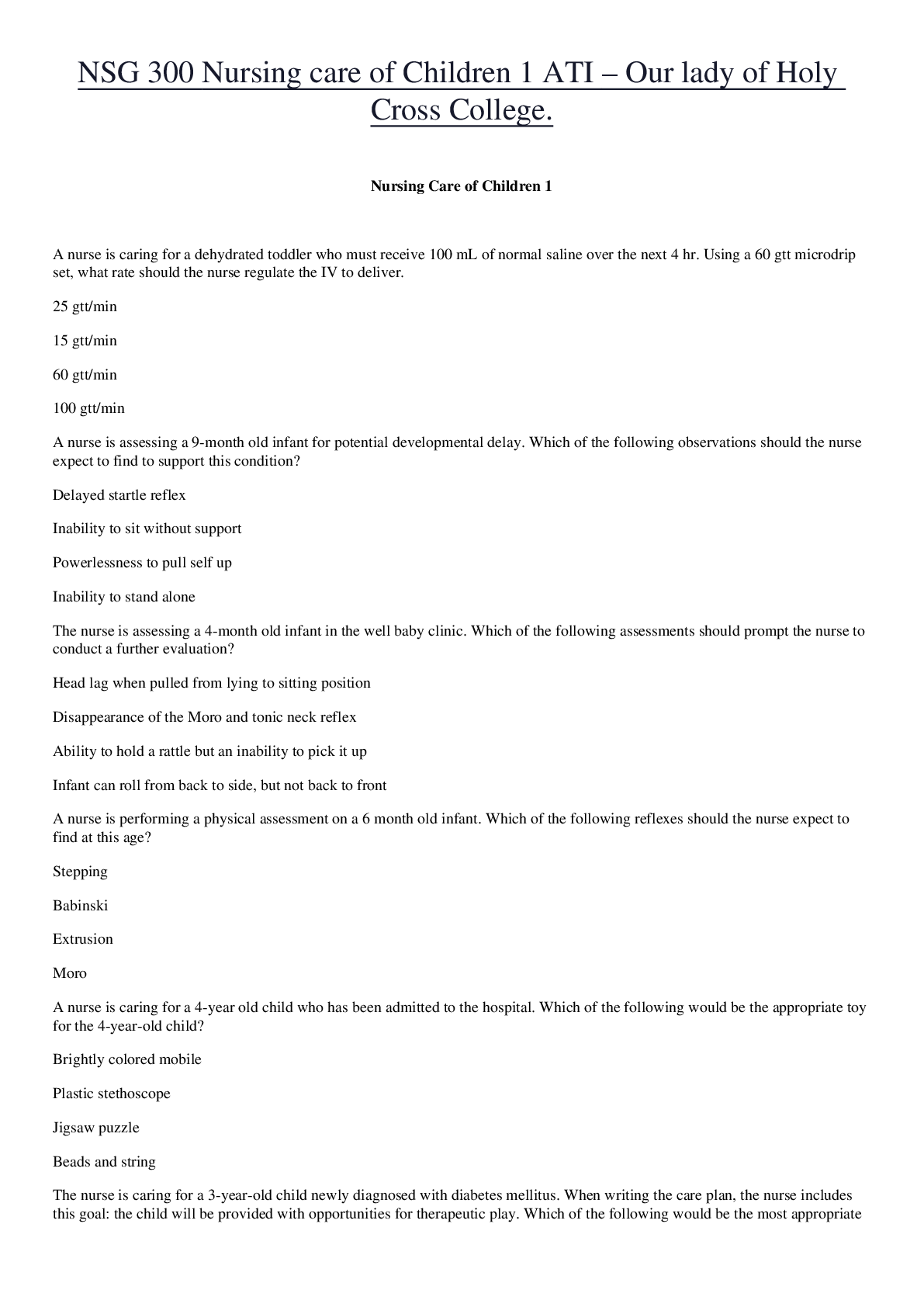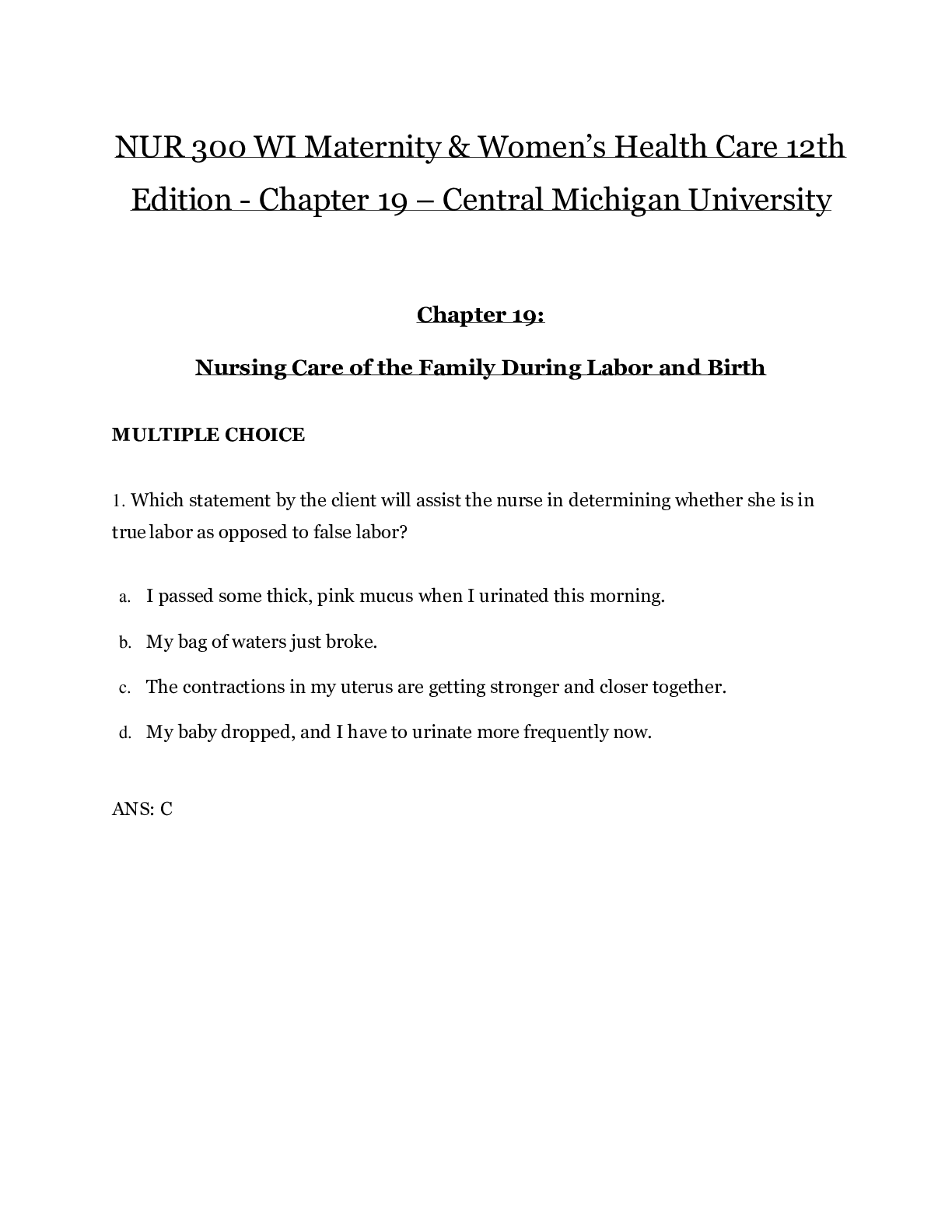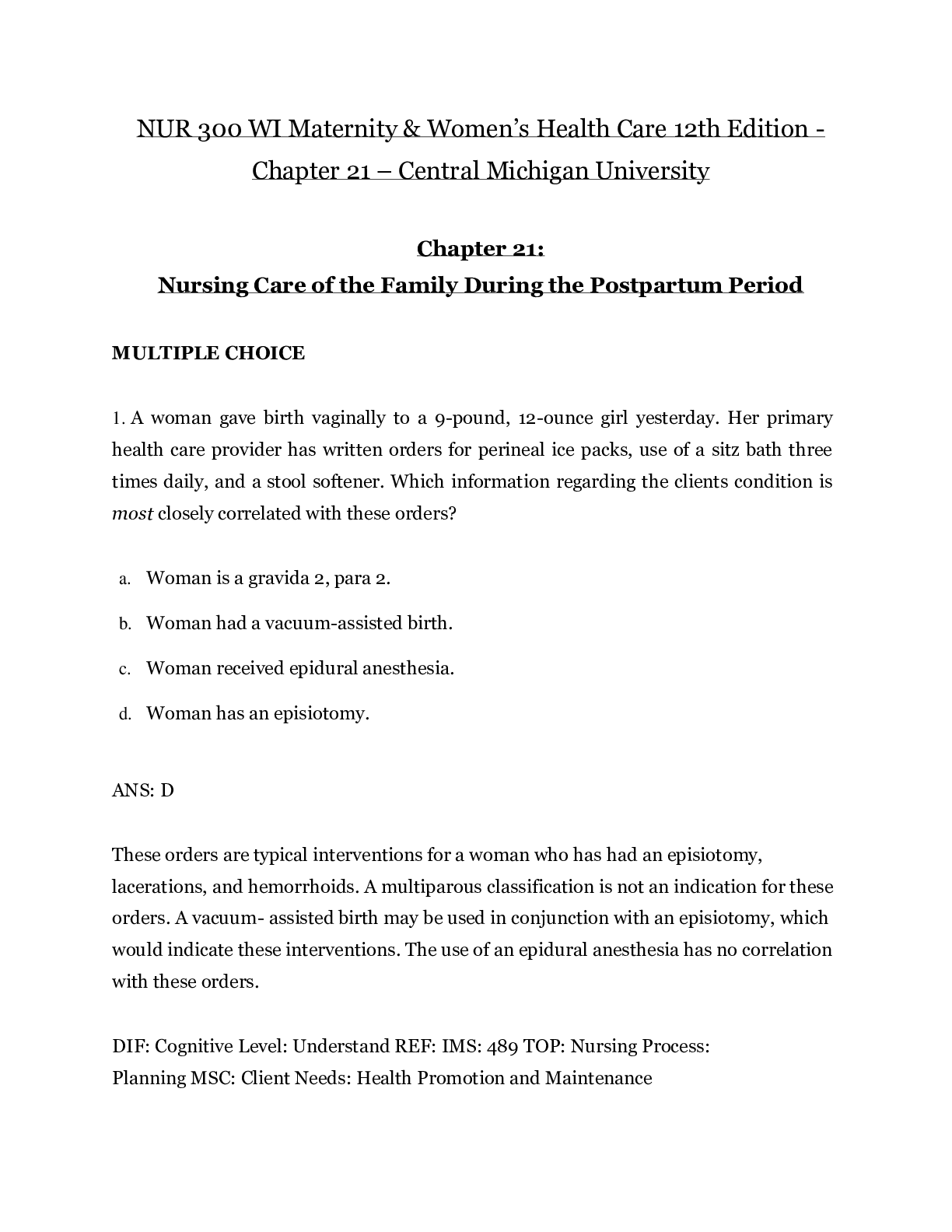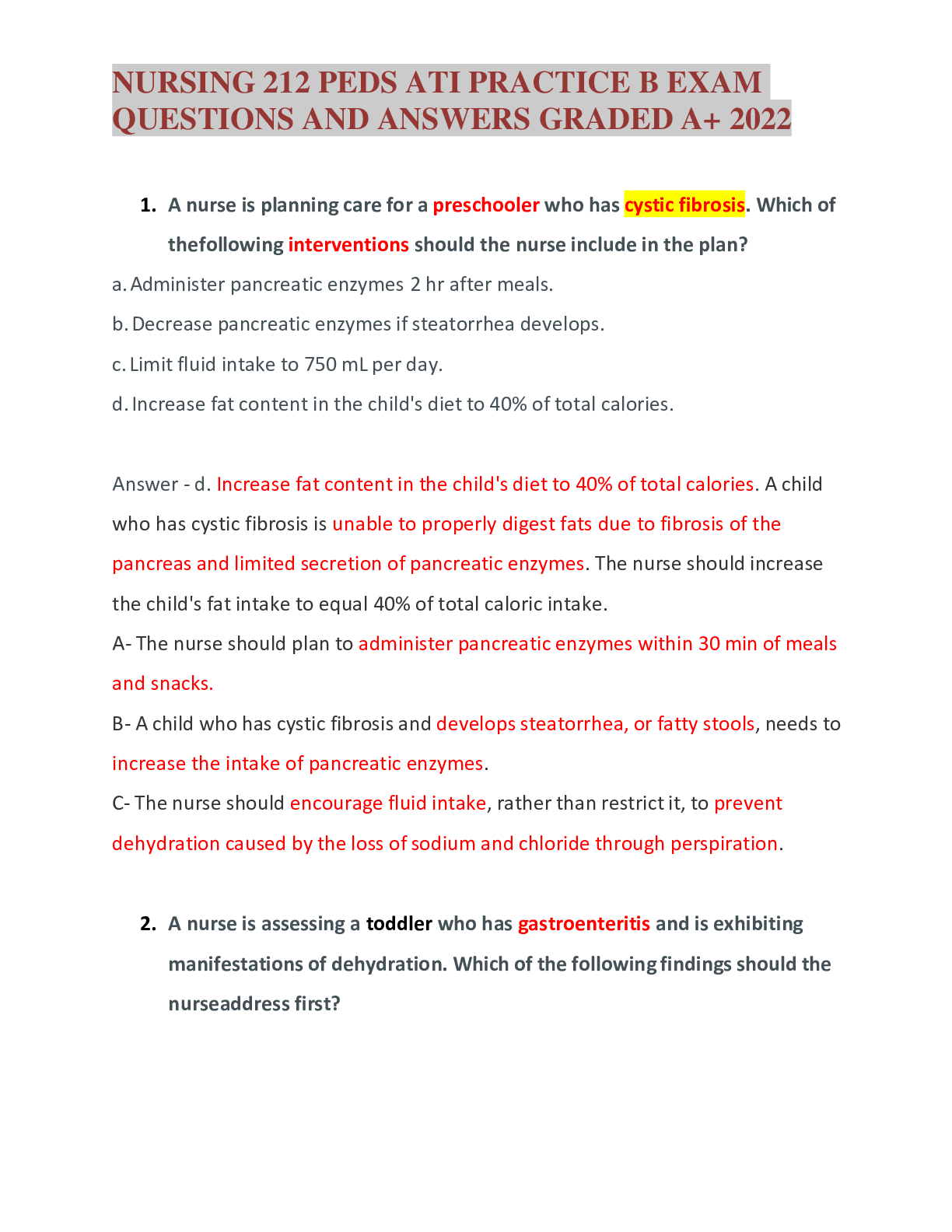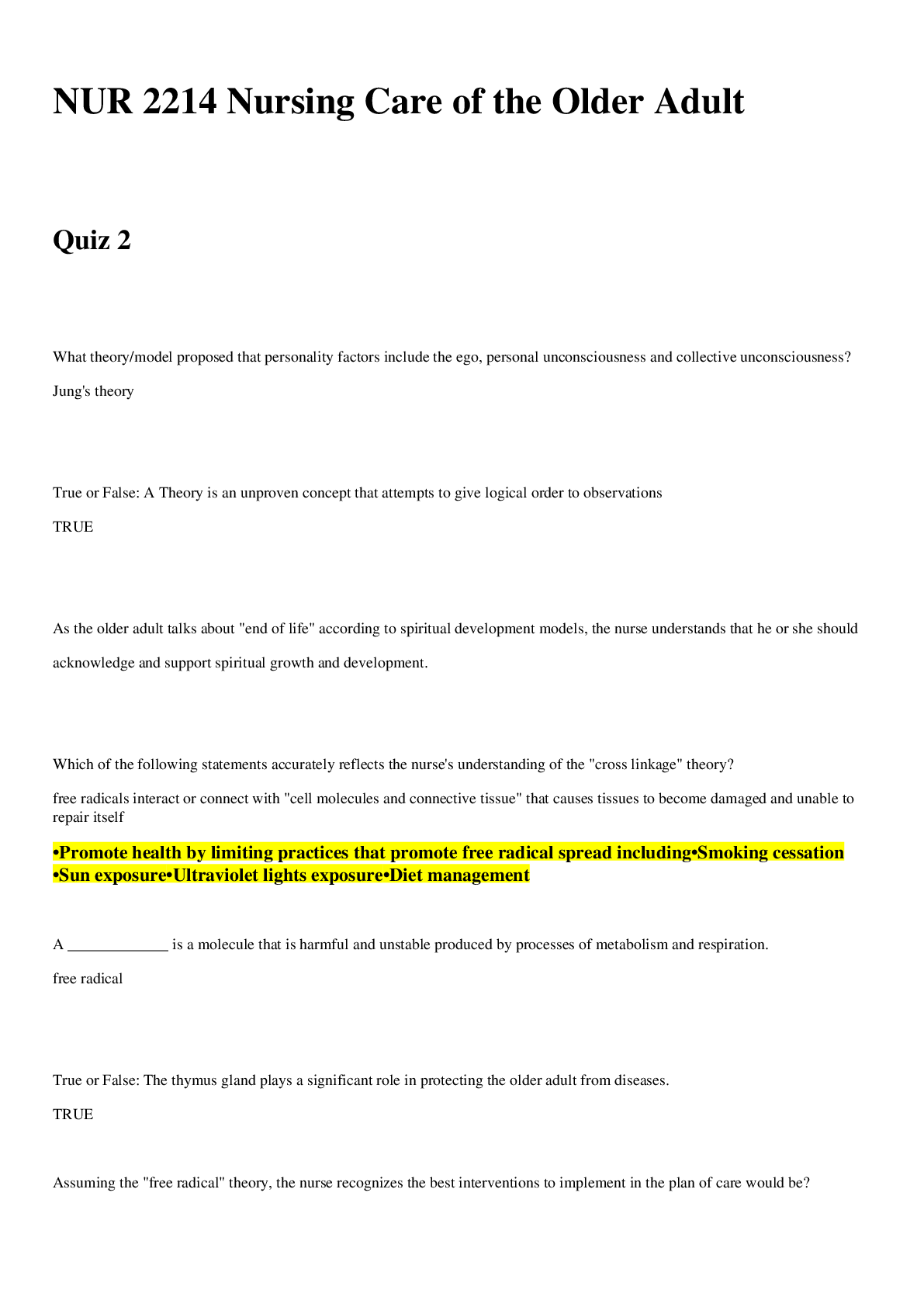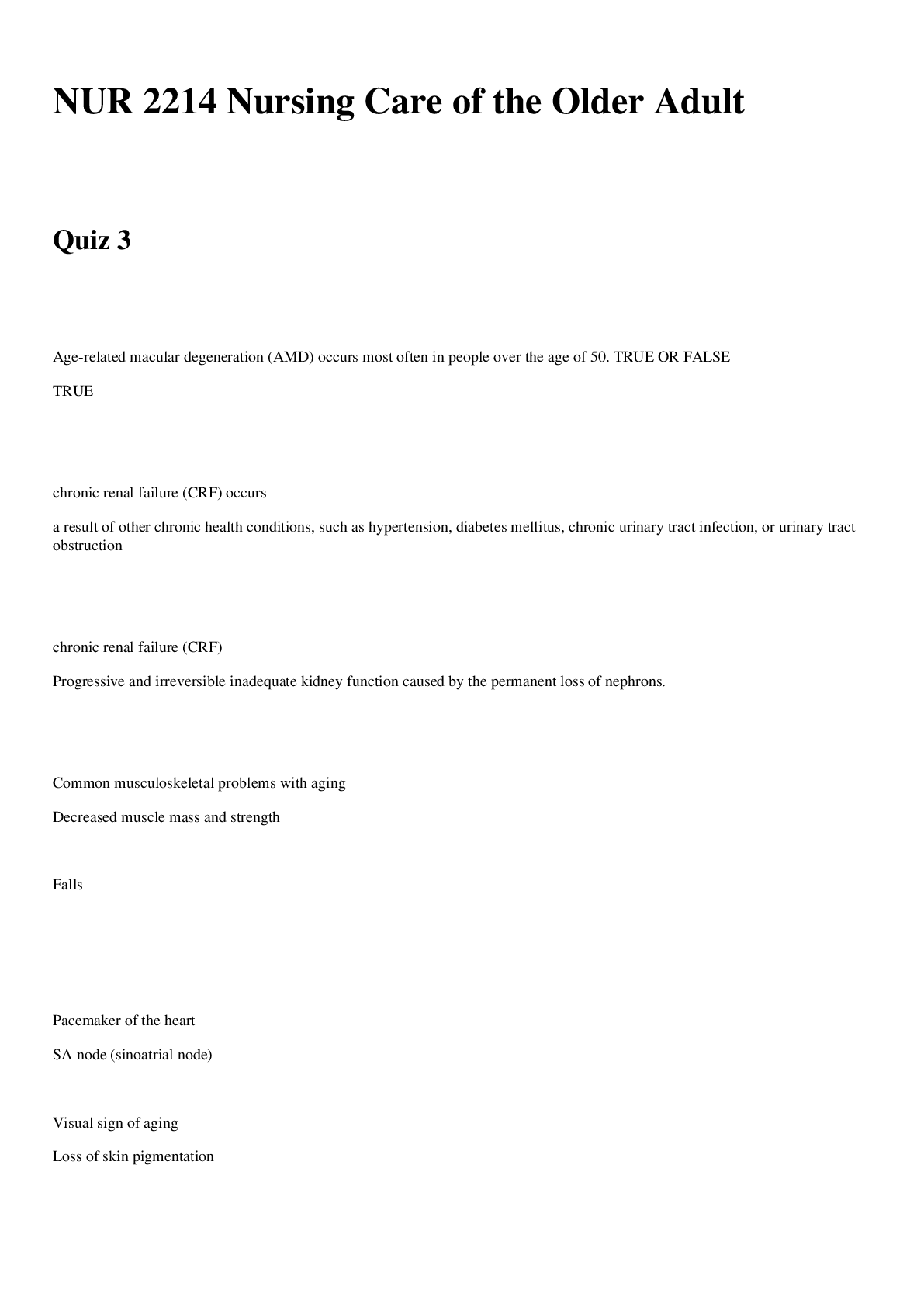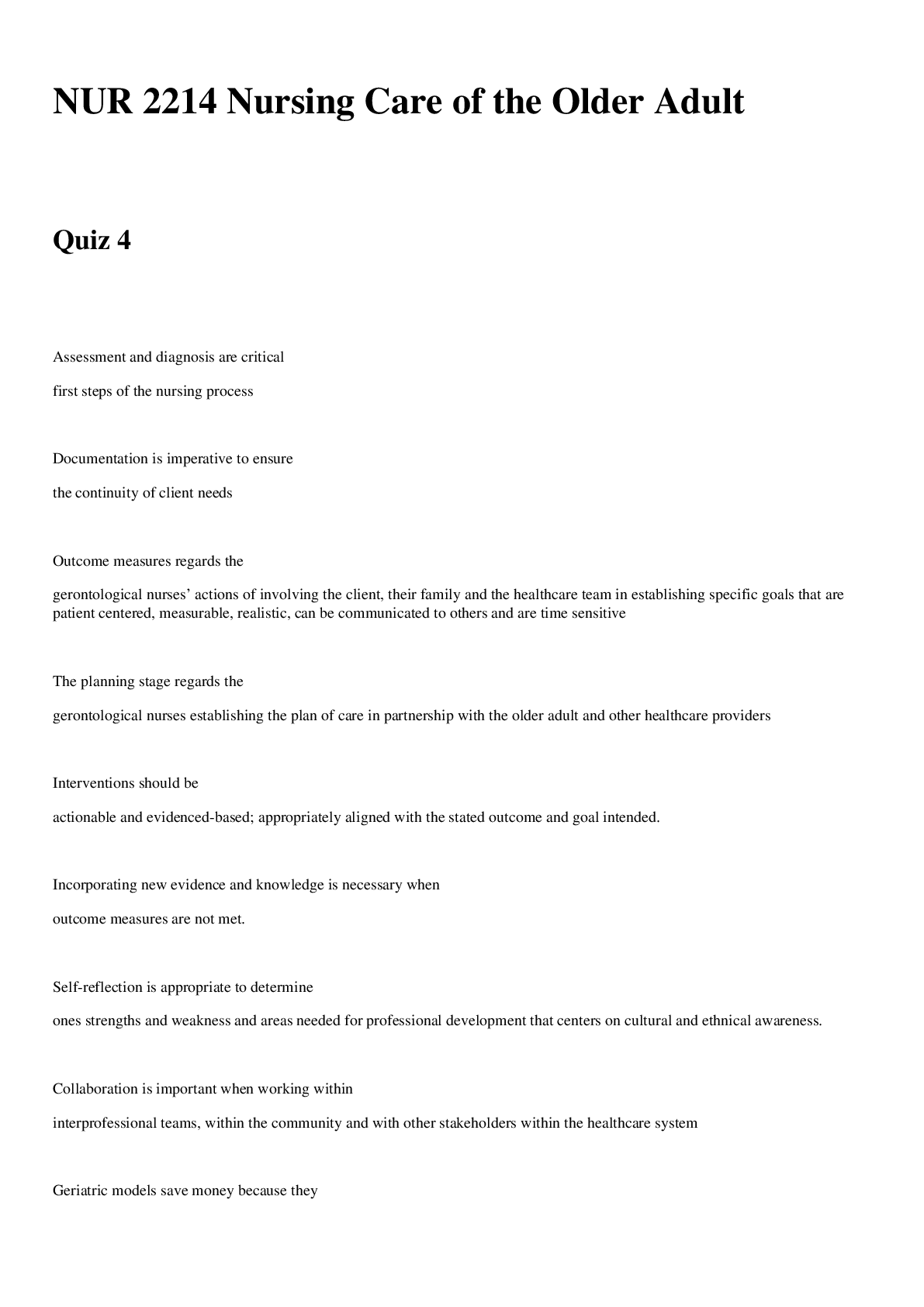*NURSING > EXAM > NURS 307ATI Real Life RN Nursing Care of Children Well Child.pdf/COMPLETE GUIDE TO SCORE A (All)
NURS 307ATI Real Life RN Nursing Care of Children Well Child.pdf/COMPLETE GUIDE TO SCORE A
Document Content and Description Below
NURS 307 ATI Real Life RN Nursing Care of Children Well Child.pdf Reasoning Scenario Performance related to Outcomes: Body Function Strong Satisfactory Needs Improvement Cardiac Output and Tissu... e Perfusion 100% Cognition and Sensation 100% Ingestion, Digestion, Absorption & Elimination 100% Mobility 100% Regulation and Metabolism 100% NCLEX RN Strong Satisfactory Needs Improvement Safety and Infection Control RN 2010 100% Health Promotion and Maintenance RN 2010 100% Psychosocial Integrity RN 2010 100% Basic Care and Comfort RN 2010 100% Pharmacological and Parenteral Therapies RN 2010 100% Reduction of Risk Potential RN 2010 100% QSEN Strong Satisfactory Needs Improvement Safety 100% Patient-Centered Care 100% Informatics 100% Decision Log: Optimal Decision Scenario The provider has not seen Kellen since his 6-week checkup. Question Nurse Denise discusses Kellen’s immunization status, and Ms. Ralston appears upset. Which of the following responses by Denise is appropriate? Selected Option “You appear upset. Can we discuss your thoughts regarding immunizations?” Rationale This response acknowledges the client is upset and seeks clarification of her perceptions of immunizations. Optimal Decision Scenario Nurse Denise is taking Kellen’s vital signs. Question Nurse Denise auscultates Kellen’s heart. Which of the following heart rates is within the expected range for Kellen? Selected Option 89/min Rationale A heart rate of 89/min is within the expected reference range for a 24-month-old child. Optimal Decision Scenario Nurse Denise discusses Kellen’s developmental milestones and gross motor skills. Question Nurse Denise is preparing to assess Kellen’s gross motor development. Which of the following gross motor skills should Kellen accomplish? (Select all that apply.) Selected Ordering Kick a ball forward Walk up and down stairs with two feet on each step Use a wide stance when running Rationale At age 2, toddlers should kick a ball forward without overbalancing, go up and down stairs alone with two feet on each step, and run reasonably well with a wide stance. At age 2, toddlers are not coordinated enough to balance on one foot or jump off the bottom step. These gross motor skills occur between the ages of 3 and 4. Optimal Decision Scenario Nurse Denise completes an assessment of Kellen’s gross motor skills and is preparing to assess Kellen’s fine motor skills. Question Nurse Denise is preparing to assess Kellen’s fine motor development. Which of the following fine motor skills should Denise include in the assessment plan? (Select all that apply.) Selected Ordering Stack six or seven blocks Unscrew lids on a container Turn each page of a book Place small objects in a narrow-necked container Rationale At age 2, toddlers can stack six or seven blocks, unscrew lids on a container, turn each page of a book, and place small objects in a narrow-necked container. At age 2, toddlers are not coordinated enough to draw a circle with eyes and nose. These fine motor skills occur at age 3. Optimal Decision Scenario The nurse assesses Kellen’s language development. Question Nurse Denise assesses Kellen’s language development. Which of the following audio clips represents typical language development for a 24-month-old child? (Click to play the audio file.) Selected Option “I love you.” Rationale By 24 months of age, a child should be speaking two- to three-word phrases. Page 3 of 9 Optimal Decision Scenario Nurse Denise educates Ms. Ralston prior to administering the measles, mumps, rubella (MMR) and varicella vaccines. Question Nurse Denise is teaching Ms. Ralston about immunizations. Which of the following information should Denise include about measles, mumps, rubella (MMR) and varicella vaccines? (Select all that apply.) Selected Ordering Mild illness is not a reason to delay vaccination with the MMR and varicella vaccines.MMR and varicella vaccines should be administered subcutaneously.The client who has an egg allergy can receive the MMR and varicella vaccines. Rationale Vaccination should not be delayed because of the presence of mild respiratory tract illness or other acute illness with or without fever. The nurse should administer the MMR and varicella vaccines subcutaneously. An allergy to eggs is not a contraindication to administration of the MMR and varicella vaccines; however, a gelatin allergy is a contraindication to receiving the vaccines. There is no causal link between MMR and varicella vaccines and autism. Optimal Decision Scenario Nurse Denise calculates the ibuprofen dosage for Kellen. Question Nurse Denise is calculating Kellen’s dose of ibuprofen (Advil). Available is a liquid preparation that contains 100 mg/5 mL. The label indicates to administer 10 mg/kg/dose. Kellen weighs 27.5 lb. How many mL should Denise tell Ms. Ralston to administer? (Round the answer to the nearest tenth.) Selected Option 6.3 Rationale Ratio and Proportion STEP 1: What is the unit of measurement to calculate? kg STEP 2: Set up an equation and solve for X. 2.2 lb/1 kg = Client's weight in lb/X kg 2.2 lb/1 kg = 27.5 lb/X kg X = 12.5 STEP 3: Round if necessary. STEP 4: Reassess to determine if the equivalent makes sense. If 1 kg = 2.2 lb, it makes sense that 27.5 lb = 12.5 kg. STEP 5: What is the unit of measurement to calculate? mg/dose STEP 6: Set up an equation and solve for X. mg x kg/dose = X 10 mg x 12.5 = 125 mg/dose STEP 7: Round if necessary. STEP 8: Reassess to determine if the equivalent makes sense. If 10 mg/kg/dose is prescribed and the client weighs 12.5 kg, it makes sense that the client should receive 125 mg/dose. STEP 9: What is the unit of measurement to calculate? mL STEP 10: What is the dose needed? Dose needed = Desired. 125 mg STEP 11: What is the dose available? Dose available = Have. 100 mg STEP 12: Should the nurse convert the units of measurement? No STEP 13: What is the quantity of the dose available? 5 mL STEP 14: Set up an equation and solve for X. Have/Quantity = Desired/X 100 mg/5 mL = 125 mg/X mL X = 6.25 mL STEP 15: Round if necessary. 6.25 = 6.3 mL STEP 16: Reassess to determine if the equivalent makes sense. If there is 100 mg/5 mL and the prescribed dose is 125 mg, it makes sense to administer 6.3 mL. The nurse should administer ibuprofen 6.3 mL orally. Optimal Decision Scenario Nurse Denise is discussing immunizations with Chloe and her father. Question Nurse Denise is discussing immunizations with Chloe and her father. Which of the following vaccinations should Denise anticipate administering to Chloe today? (Select all that apply.) Selected Ordering Hepatitis A (Hep A) Meningococcal Tetanus, diphtheria, acellular pertussis (Tdap) Human Papilloma Virus (HPV) Rationale According to the Centers for Disease Control and Prevention guidelines, this client is missing the Tdap booster, HPV series, Hep A, series and meningococcal immunization. The DTaP series has been completed, and the rotavirus is not initiated 15 weeks or older. Optimal Decision Scenario Nurse Denise calculates and plots Chloe’s body mass index (BMI). Question Nurse Denise calculates Chloe’s body mass index (BMI) using this formula: weight (kg) divided by stature (cm) divided by stature (cm) multiplied by 10,000 or weight (lb) divided by stature (in) divided by stature (in) multiplied by 703. Select the area of the chart where Denise should plot Chloe’s BMI. (Selectable areas, or “Hot Spots,” can be found by moving your cursor over the artwork until the cursor changes appearance, usually into a hand. Click only on the Hot Spot that corresponds to your answer.) Selected Option BMI is plotted as 30. Rationale The calculated BMI of 30 is correct. Weight in pounds (height in inches x height in inches) x 703 = BMI 200 / (68 x 68) x 703 = 30.4 = 30 Optimal Decision Scenario Nurse Denise discusses weight loss ideas with Chloe. Question Nurse Denise prepares to discuss weight loss ideas with Chloe. Which of the following should Denise recommend Chloe integrate on a daily basis? Selected Option Be physically active for at least 60 min. Rationale In addition to calorie reduction, the nurse should recommend physical activity for at least 60 min per day. Optimal Decision Scenario Beth, the nurse practitioner, and Chloe are discussing her dysmenorrhea. Question Nurse Practitioner Beth, is educating Chloe about the use of ibuprofen (Advil) to minimize dysmenorrhea. Which of the following should Beth include in the teaching? Selected Option Notify the provider immediately if you experience dark tarry stools. Rationale Although research studies show ibuprofen produces less gastric bleeding compared with aspirin, the client should contact the nurse or another health care provider if this occurs. Scenario Nurse practitioner Beth, is completing a physical exam of Chloe and considers additional topics to discuss. Question Nurse practitioner Beth, is completing a physical exam of Chloe and considers additional topics to discuss. List three topics Beth should include in her discussion with Chloe. (Fill in the blank and click on the Submit button when you finish.) Selected Option -Periods. -Exercise. -Sexual activity. -Drugs. Rationale 1. School and level of interest: How well does the client do in school and what is her level of interest? Does she take responsibility for schoolwork and complete it on time? 2. Relationship with peers: Has the client ever been stalked or bullied in person or online? How does she feel about cyber bullying? 3. Sexuality: How is the client responding to developmental changes? Is she in or has she had a heterosexual, and/or homosexual relationship? Has she had oral, vaginal, or anal sex, wanted or unwanted? Has she ever been forced or pressured to do something sexual that she did not want to do? If sexually active, are her partners younger, older, or the same age? Does she use condoms or other contraceptives? 4. Psychological health: Is the client moody or does she have outbursts? Does she feel bored, sad, or irritable most of the time? Does she ever feel so sad she wishes she were not alive or wants to die? How does she manage conflict? How does she find ways to deal with stress? Does she overeat when stressed? 5. Development related to risk of injury: Does the client tan? Does she wear her car seat belt? Does she wear a helmet or protective gear when biking or participating in roller sports? Does she have someone she can call for a ride if she feels unsafe riding with someone? Does she feel indestructible? 6. Recreational use of substances: Has the client ever experimented with smoking, tobacco, alcohol, drugs, or steroids? Has she sniffed, huffed, or breathed anything to get high? Do her friends do any of these activities? Optimal Decision Scenario Nurse Denise plots Fay’s height and weight on a growth chart. Question Nurse Denise is plotting Fay’s height and weight on the growth chart. Identify the two locations that correspond to Fay’s height and weight at today’s well- baby check. (Selectable areas, or “Hot Spots,” can be found by moving your cursor over the artwork until the cursor changes appearance, usually into a hand. Click only on the two Hot Spots that correspond to your answer.) Selected Ordering Height = 66 cm Weight = 18 lb Rationale The client’s height reflects the 75th percentile and her weight reflects the 80th percentile, which indicates growth within the expected range for a 6-month-old infant. Optimal Decision Scenario Nurse Denise begins a developmental screening of fine motor skills. Question Nurse Denise performs a developmental screening of fine motor skills on Fay. Which of the following fine motor skills should Fay demonstrate? Selected Option Holds her bottle when feeding Rationale At 6 months, the client should be able to hold her own bottle. Optimal Decision Scenario Nurse Denise reviews appropriate food choices for a 6-month-old with Fay’s parents. Question Nurse Denise plans to review appropriate food choices with Fay’s parents. Which of the following foods are appropriate for Fay? Selected Option Finely mashed peas Rationale The client should start eating pureed, strained, or finely mashed cooked baby foods at 6 months. Optimal Decision Scenario Nurse Denise is educating Fay’s parents about home safety. Question Nurse Denise is reviewing home safety with Fay’s parents. Which of the following images illustrates a potential safety hazard for an infant? Selected Option Balloons Rationale Parents should avoid latex balloons in the home environment because they pose risks of suffocation and aspiration to children. Latex is also a common allergen during childhood. Optimal Decision Scenario Ms. Johnson is asking Nurse Denise about immunizations for Fay. Question Nurse Denise prepares the vaccines for administration to Fay. Which of the following vaccines should Denise plan to administer first? Selected Option Rotavirus Rationale Rotavirus is an oral vaccine; therefore, the nurse should administer this vaccine first because it is the least invasive. Optimal Decision Scenario Nurse Denise reviews infant acetaminophen dosage with Ms. Johnson. Question Nurse Denise reviews the appropriate dosage of acetaminophen (Tylenol) with Ms. Johnson. The provider prescribed children’s acetaminophen, which is available as 160 mg/5 mL. The recommended dose is 10 to 15 mg/kg. Fay weighs 18 lb. Which of the following is the dosage range that Denise should tell Fay’s parents to give at home? (Round the answer to the nearest tenth.) Selected Option 2.6 to 3.8 mL Rationale STEP 1: What is the unit of measurement to calculate? kg STEP 2: Set up an equation and solve for X. 2.2 lb/1 kg = Client's weight in lb/X kg 2.2 lb/1 kg = 18 lb/X kg X = 8.1818 STEP 3: Round if necessary. 8.1818 = 8.2 STEP 4: Reassess to determine if the equivalent makes sense. If 1 kg = 2.2 lb, it makes sense that 18 lb = 8.2 kg. STEP 5: What is the unit of measurement to calculate? mg STEP 6: Set up an equation and solve for X. mg/kg/day 10 mg x 8.2 kg = X mg/day X = 82 mg/kg/day 15 mg x 8.2 kg = X mg/day X = 123 STEP 7: Round if necessary. STEP 8: Reassess to determine if the amount to administer makes sense. If the prescribed amount is 10 mg/kg/dose and the client weighs 8.2 kg, it makes sense to administer 82 to 123 mg per dose. STEP 9: What is the unit of measurement to calculate? mL STEP 10: What is the dose needed? Dose needed = Desired. 82 to 123 mg STEP 11: What is the dose available? Dose available = Have. 160 mg STEP 12: Should the nurse convert the units of measurement? No STEP 13: What is the quantity of the dose available? 5 mL STEP 14: Set up an equation and solve for X. Have/Quantity = Desired/X 160 mg/5 mL = 82 mg/X mL X = 2.5625 mL 160 mg/5 mL = 123 mg/X mL X = 3.8437 mL STEP 15: Round if necessary. 2.5652 = 2.6 3.8437 = 3.8 STEP 16: Reassess to determine if the amount to administer makes sense. If there are 160 mg/5 mL and the prescribed dose is 82 to 123 mg, it makes sense to administer 6.3 mL. The nurse should administer 2.6 to 3.8 mL. Individual Report – Score Explanation and Interpretation Reasoning Scenario Information: Reasoning Scenario Information provides the date, time and duration of use, along with the score earned for each attempt. A Reasoning Scenario Performance score of Strong, Satisfactory, or Needs Improvement is provided for each attempt. This information is also provided for the Optimal Decision Mode if it has been enabled. Reasoning Scenario Performance Scores: Strong Exhibits optimal reasoning that results in positive outcomes in the care of clients and resolution of problems. Satisfactory Exhibits reasoning that results in mildly helpful or neutral outcomes in the care of clients and resolution of problems. Needs Improvement Exhibits reasoning that results in harmful or detrimental outcomes in the care of clients and resolution of problems. Reasoning Scenario Performance Related to Outcomes: A clinical reasoning performance score related to each outcome is provided. Outcomes associated with student responses are listed in the report. The number across from each outcome indicates the percentage of responses associated with the level of performance of that outcome. NCLEX® Client Need Categories: Management of Care Providing integrated, cost‐effective care to clients by coordinating, supervising, and/or collaborating with members of the multi‐disciplinary health care team. Safety and Infection Control Incorporating preventative safety measures in the provision of client care that provides for the health and well‐being of clients, significant others, and members of the health care team. Health Promotion and Maintenance Providing and directing nursing care that encourages prevention and early detection of illness, as well as the promotion of health. Psychosocial Integrity Promoting mental, emotional, and social well‐being of clients and significant others through the provision of nursing care. Basic Care and Comfort Promoting comfort while helping clients perform activities of daily living. Pharmacological and Parenteral Therapies Providing and directing administration of medication, including parenteral therapy. Reduction of Risk Potential Providing nursing care that decreases the risk of clients developing health‐ related complications. Physiological Adaptation Providing and directing nursing care for clients experiencing physical illness. Quality and Safety Education for Nurses (QSEN) Safety The minimization of risk factors that could cause injury or harm while promoting quality care and maintaining a secure environment for clients, self, and others. Patient‐Centered Care The provision of caring and compassionate, culturally sensitive care that is based on a client’s physiological, psychological, sociological, spiritual, and cultural needs, preferences, and values Evidence Based Practice The use of current knowledge from research and other credible sources, upon which clinical judgment and client care are based. Informatics The use of information technology as a communication and information gathering tool that supports clinical decision making and scientifically based nursing practice. Quality Improvement Care related and organizational processes that involve the development and implementation of a plan to improve health care services and better meet the needs of clients. Teamwork and Collaboration The delivery of client care in partnership with multidisciplinary members of the health care team, to achieve continuity of care and positive client outcomes. Body Function Cardiac Output and Tissue Perfusion Cognition and Sensation The anatomical structures (heart, blood vessels, and blood) and body functions that support adequate cardiac output and perfusion of body tissues. The anatomical structures (brain, central and peripheral nervous systems, eyes and ears) and body functions that support perception, interpretation, and response to internal and external stimuli. Excretion The anatomical structures (kidney, ureters, and bladder) and body functions that support filtration and excretion of liquid wastes, regulate fluid and electrolyte and acid‐base balance. Immunity The anatomic structures (spleen, thymus, bone marrow, and lymphatic system) and body functions related to inflammation, immunity, and cell growth. Ingestion, Digestion, Absorption and Elimination The anatomical structures (mouth, esophagus, stomach, gall bladder, liver, small and large bowel, and rectum) and body functions that support ingestion, digestion, and absorption of food and elimination of solid wastes from the body. Integument The anatomical structures (skin, hair, and nails) and body functions related to protecting the inner organs from the external environment and injury. Mobility The anatomical structures (bones, joints, and muscles) and body functions that support the body and provide its movement. Oxygenation The anatomical structures (nose, pharynx, larynx, trachea, and lungs) and body functions that support adequate oxygenation of tissues and removal of carbon dioxide. Regulation and Metabolism The anatomical structures (pituitary, thyroid, parathyroid, pancreas, and adrenal glands) and body functions that regulate the body’s internal environment. Reproduction The anatomical structures (breasts, ovaries, fallopian tubes, uterus, vagina, vulva, testicles, prostate, scrotum, and penis) and body functions that support reproductive functions. Decision Log Information related to each question answered in a scenario attempt is listed in the report. A brief description of the scenario, question, selected option and rationale for that option are provided for each question answered. The words “Optimal Decision” appear next to the question when the most optimal option was selected. The rationale for each selected option may be used to guide remediation. A variety of learning resources may be used in the review process, including related ATI Review Modules. [Show More]
Last updated: 1 year ago
Preview 1 out of 12 pages
Instant download
.png)
Buy this document to get the full access instantly
Instant Download Access after purchase
Add to cartInstant download
Reviews( 0 )
Document information
Connected school, study & course
About the document
Uploaded On
Jul 13, 2021
Number of pages
12
Written in
Additional information
This document has been written for:
Uploaded
Jul 13, 2021
Downloads
0
Views
64

